

Why Mobile Learning Apps Are The Future of Education. Mobile learning apps and students, they exist like the original odd couple.
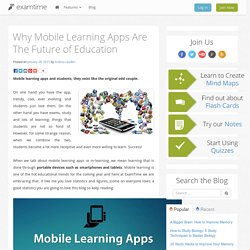
On one hand you have the app, trendy, cool, ever evolving and students just love them. On the other hand you have exams, study and lots of learning; things that students are not so fond of. However, for some strange reason, when we combine the two, students become a lot more receptive and even more willing to learn. Success! Mobile Learning: How Students Use Mobile Devices to Support Learning. Cellphones in the Classroom: Distraction or Tool? The final version of the National Education Technology Plan (NETP) was released last week, setting forth the Obama Administration's plan for improving access to and integration of technologies for teaching and learning.

Among the recommendations the Department of Education makes in the NETP is a call for support for "efforts to ensure that all students and educators have 24/7 access to the Internet via devices, including mobile devices, and that states, districts, and schools adopt technologies and policies to enable leveraging the technology that students already have. " The push for "24/7 access to the Internet" falls under another the auspices of yet another endeavor, the National Broadband Plan. But the call for better access to Internet-ready devices, particularly utilizing tools the students already possess is an interesting one. Because the device that is ubiquitous for American students isn't the desktop computer or the notebook or the netbook or the iPad. How to Use Cell Phones as Learning Tools. Does your staff need Educational Technology training?

The K-12 Teachers Alliance can help you plan your in-service professional development at no additional cost. Is All This Student Data Changing the Way Teachers Teach? Christy Novack works with students in her Burlingame, Calif. classroom.
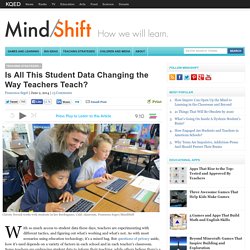
Francesca Segre/MindShift. To Ban or Not to Ban: Schools Weigh Cell Phone Policies. Flickr:From_Ko Last week, a study by the Pew Internet and American Life Project found that cellphones have become “near ubiquitous”: 83% of American adults own one.
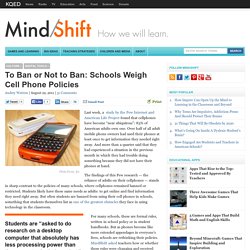
Over half of all adult mobile phone owners had used their phones at least once to get information they needed right away. And more than a quarter said that they had experienced a situation in the previous month in which they had trouble doing something because they did not have their phones at hand. The findings of this Pew research — the reliance of adults on their cellphones — stands in sharp contrast to the policies of many schools, where cellphones remained banned or restricted. Amidst a Mobile Revolution in Schools, Will Old Teaching Tactics Work? Getty Just a few years ago, the idea of using a mobile phone as a legitimate learning tool in school seemed far-fetched, if not downright blasphemous.

Kids were either prohibited from bringing their phones to school, or at the very least told to shut it off during school hours. But these days, it’s not unusual to hear a teacher say, “Class, turn on your cell. More School Districts Welcome Cell Phones in the Class. Innovation in ISD.
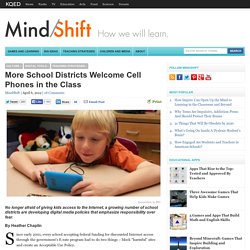
How Teachers Make Cell Phones Work in the Classroom. A.P.
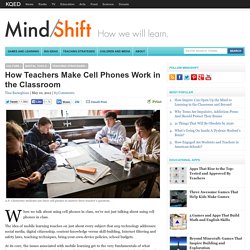
Chemistry students use their cell phones to answer their teacher's question. When we talk about using cell phones in class, we’re not just talking about using cell phones in class. The idea of mobile learning touches on just about every subject that any technology addresses: social media, digital citizenship, content-knowledge versus skill-building, Internet filtering and safety laws, teaching techniques, bring-your-own-device policies, school budgets. At its core, the issues associated with mobile learning get to the very fundamentals of what happens in class everyday. At their best, cell phones and mobile devices seamlessly facilitate what students and teachers already do in thriving, inspiring classrooms.
“Bring Your Own Device” and the digital divide. It was at the South By Southwest Edu conference in Austin earlier this month that I first heard the term B.Y.O.D. or B.Y.O.T.–”Bring Your Own Device” or “Bring Your Own Technology.”

Creating a "Least Restrictive Environment" with Mobile Devices. The U.S.
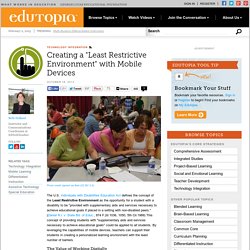
Individuals with Disabilities Education Act defines the concept of the Least Restrictive Environment as the opportunity for a student with a disability to be "provided with supplementary aids and services necessary to achieve educational goals if placed in a setting with non-disabled peers. " (Daniel R.r. v. Mobile Learning Support for New Teachers. The mobile learning revolution is alive and growing in popularity every day.
When schools move toward mobile learning in the classroom, they can take advantage of electronic devices such as tablets and cell phones that offer portability and ease of use. Mobile learning technologies can offer teachers a flexible approach to learning with their students in a variety of locations, and encourage this learning to continue at home. As schools begin to consider the movement towards mobile learning, it's important to support teachers with strategies for success, particularly if they are new. A Mobile Dilemma. About three years ago, while I was teaching education at a local college, I was attempting to do an observation of one of my students at her student teaching assignment. Mobile Learning: Resource Roundup.
Facebook Edutopia on Facebook Twitter Edutopia on Twitter Google+ Pinterest. Five-Minute Film Festival: Mobile Learning. As technology evolves, it's important to make time for fresh beginnings and innovative ideas. For some, this could include a new perspective on the devices that are becoming so ubiquitous in our lives -- mobile gadgets like smartphones, tablets, mp3 players, and eReaders.
Accessing Multimedia Using QR Codes. Students of all ages are required to read text for a variety of purposes. With a large emphasis placed on teaching skills that help children tackle nonfiction, it's important to think about the different ways that students are gathering facts and details as they take in information. Teachers need to think beyond traditional text and make sure that their students have the necessary skills for processing, evaluating, and comprehending multimedia.
Not a Trend, But a Tool Locating and sharing high quality multimedia content can be difficult. Even when you've found the perfect text to share with students, the next step can be logistically challenging. The First 5s with iPads. Smartphones: From Toy to Tool.